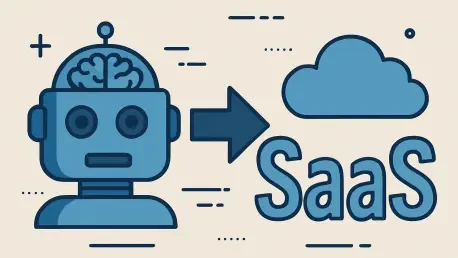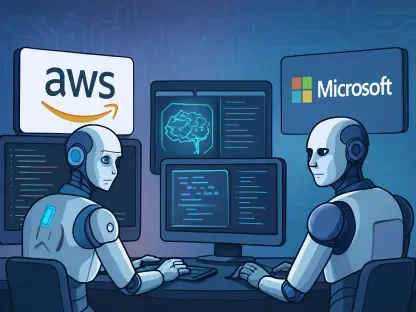Imagine a world where business software no longer requires clicking through dashboards or navigating complex interfaces, but instead responds instantly to a simple voice command or text prompt. This scenario is no longer a distant dream but a pressing reality as AI agents—autonomous tools designed to execute tasks with minimal human input—gain traction in the tech landscape. As Software as a Service (SaaS) remains a cornerstone of modern business operations, delivering subscription-based solutions for everything from project management to data analytics, the rise of AI agents raises a critical question: could they disrupt or even replace the SaaS model entirely? This roundup gathers insights from various industry leaders and tech innovators to explore the collision of these two forces, comparing diverse perspectives on whether SaaS will adapt, evolve, or fade in the face of AI-driven automation.
Setting the Stage: The Clash Between AI Agents and SaaS
The SaaS model has revolutionized how companies access software, offering scalable, cloud-based tools that eliminate the need for heavy upfront investments in hardware or licensing. However, AI agents are emerging as potential game-changers, capable of performing tasks like data analysis or customer support without the traditional graphical interfaces that define SaaS platforms. Their ability to interact via natural language or directly through APIs challenges the very foundation of user-centric software delivery.
This intersection carries significant implications for businesses, tech providers, and end users alike. For companies, the shift could mean reduced dependency on multiple SaaS subscriptions if AI agents streamline operations. For providers, it poses a risk of obsolescence unless adaptation occurs swiftly. End users might face a learning curve but could benefit from more intuitive interactions. The stakes are high in this rapidly digitizing environment where efficiency often dictates market survival.
To unpack this dynamic, opinions from various industry voices offer a spectrum of predictions—from total disruption to symbiotic integration. The following sections delve into whether AI agents will redefine software delivery or if SaaS can hold its ground through innovation and user loyalty.
Unpacking the Debate: Can AI Agents Transform Software Delivery?
The Threat of Invisible Software: AI Bypassing User Interfaces
A compelling argument in the tech community suggests that AI agents could render traditional SaaS dashboards obsolete by handling tasks directly through natural language or backend integrations. Industry leaders have highlighted a potential shift where users no longer interact with visual interfaces but instead issue commands like “summarize quarterly sales” to an agent that processes the request instantly. This vision points to a future where software becomes nearly invisible to the user.
Supporters of this perspective argue that within a short span—potentially just 18 months from 2025—AI agents could orchestrate complex workflows across multiple systems without requiring human navigation of tools like analytics platforms. The elimination of graphical user interfaces (GUIs) could streamline operations, especially for repetitive or data-heavy tasks, reducing the friction often associated with SaaS tools.
Yet, skepticism persists about whether AI can fully replace the tactile and visual elements of user-centric design. Critics note that many users still value the clarity and control offered by well-designed interfaces, raising doubts about the readiness of agents to handle nuanced or creative tasks. This tension between automation and human interaction remains a focal point of contention.
Market Evolution: Which SaaS Segments Are Most Vulnerable?
Not all SaaS offerings face the same level of risk from AI agents, according to industry observations. Niche point solutions—specialized tools that address narrow functions like expense tracking or social media scheduling—appear most susceptible to displacement. AI agents, leveraging APIs, can often replicate these functions without the need for a dedicated user interface, bypassing what some call “human friction.”
In contrast, core infrastructure SaaS platforms, such as those managing enterprise resource planning or large-scale data storage, are seen as more resilient. Experts suggest these systems will likely remain integral due to their role in maintaining data integrity and supporting critical business processes. Their entrenched position in organizational workflows offers a buffer against rapid disruption.
This potential bifurcation of the SaaS market could create a divided ecosystem. Vendors of smaller, less essential tools may struggle to justify their value if AI agents take over, while larger players or those adapting to agent-friendly frameworks—such as offering robust API access—might uncover new growth opportunities. The challenge lies in predicting which segments will pivot successfully.
Convergence on the Horizon: Merging AI with SaaS Platforms
Rather than outright replacement, a growing trend points toward integration, where SaaS giants embed AI agents into their existing offerings. Major tech companies are already enhancing tools like spreadsheets and collaboration platforms with AI capabilities, allowing users to automate routine tasks while retaining familiar interfaces. This hybrid approach aims to balance innovation with continuity.
Industry voices advocate for a model where SaaS platforms serve as the backbone for data and compliance needs, while AI agents handle front-end interactions. This synergy could address enterprise concerns about security and governance, ensuring that automation does not compromise established systems. Global adoption of such hybrid solutions is already underway, reshaping user expectations.
The assumption of total disruption may be premature, as this convergence suggests a redefinition of market dynamics. Instead of competing, AI and SaaS could complement each other, creating ecosystems where automation enhances rather than eliminates the need for structured software environments. This evolving partnership merits close attention.
Beyond Automation: The Human Element SaaS Continues to Hold
Despite the push for automation, many in the industry argue that SaaS retains unique strengths beyond mere functionality. The ecosystems built around SaaS platforms—featuring intuitive design, guided workflows, and vibrant user communities—offer a human-centric value that AI agents struggle to replicate. These elements foster trust and familiarity among users.
Comparing this stance to AI-driven predictions, there is a notable divide. While agents excel at efficiency, they often lack the emotional resonance or contextual understanding embedded in well-crafted SaaS experiences. Experts speculate that long-term user preferences may lean toward tools that balance automation with a sense of control and visual organization, especially in creative or strategic domains.
This human element could shape a future where AI manages routine operations, yet SaaS maintains a pivotal role in delivering structure and reliability. The intangible strengths of governance and user loyalty might anchor SaaS as a critical layer, even as agents handle more tactical tasks. How these dynamics play out will influence software consumption for years to come.
Key Insights: Navigating the AI-SaaS Intersection
Distilling the varied perspectives, the debate spans a spectrum from viewing AI agents as a potential SaaS killer to seeing them as transformative partners in hybrid systems. On one end, the threat of invisible software looms large for vendors reliant on traditional interfaces, while on the other, integration offers a path to relevance through enhanced functionality.
For businesses and tech leaders, strategic guidance includes investing in API infrastructure to enable seamless agent interactions. Prioritizing user-friendly tools for managing AI agents can also mitigate complexity. Staying ahead requires a proactive stance, balancing automation with the human touch that SaaS often provides.
Practical steps for stakeholders involve evaluating current SaaS dependencies to identify areas ripe for AI integration. Exploring how agents can complement existing workflows, rather than replace them, could position organizations to adapt smoothly. Keeping an eye on industry trends and competitor moves remains essential in this shifting landscape.
Looking Ahead: Reflections on the AI and SaaS Journey
Reflecting on the discussions that unfolded, it became evident that the narrative surrounding AI agents and SaaS is one of transformation rather than outright replacement. The insights gathered painted a picture of coexistence, where hybrid models emerged as a practical solution to balance automation with established software frameworks. The diversity of opinions underscored the complexity of this technological shift.
Moving forward, businesses are encouraged to take actionable steps such as piloting AI agent integrations within their SaaS environments to test efficiency gains. Exploring partnerships with vendors who prioritize adaptable, agent-friendly systems offers a way to stay competitive. Additionally, investing in training for teams to manage AI tools effectively could ease the transition, ensuring that innovation enhances rather than disrupts operations.









